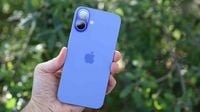Apple's upcoming iPhone 17 Pro has been generating buzz since the launch of the iPhone 16-e, with numerous leaks hinting at significant design changes and new features. While these enhancements have yet to be confirmed by the tech giant, industry insiders and supply chain experts have suggested several intriguing possibilities for the new device.
One of the most notable changes could be the introduction of an aluminum frame, marking a departure from the titanium frames used in the iPhone 15 and 16. This shift is expected to reduce the phone's weight while maintaining durability. Additionally, leaks indicate that the iPhone 17 Pro might feature a back that combines both glass and aluminum materials, enhancing its aesthetic appeal.
Another significant design modification involves the camera bump, which is rumored to resemble that of Google's Pixel. The new rectangular camera bump will reportedly have rounded corners, with the camera sensors arranged in a triangular pattern. The flash and microphone sensor are expected to be positioned in the left-hand corner of the device, further distinguishing it from previous models.
Performance-wise, the iPhone 17 Pro is anticipated to utilize Apple's next-generation A19 Pro chip, which will be manufactured using TSMC's advanced third-generation 3nm process. This new chip is expected to enhance processing power and efficiency, making the device faster and more responsive. Furthermore, the phone is rumored to come with a larger battery, which should optimize battery life for users.
Connectivity upgrades are also on the horizon, with the iPhone 17 Pro likely to incorporate a Wi-Fi 7 chip designed specifically by Apple. This will enhance wireless connectivity, allowing for faster data transfer and improved performance in crowded areas.
In terms of camera capabilities, the iPhone 17 Pro is rumored to feature a 24 MP front camera and a 48 MP rear telephoto camera, offering users enhanced photography options. Coupled with 12 GB of RAM and a revamped architecture focused on better cooling—thanks to a vapor cooling chamber—this model is expected to deliver an impressive user experience.
However, not all news from Apple is about new releases. The company has reportedly no plans to reintroduce the iPhone Mini, a compact model that garnered a niche following but failed to achieve widespread success. Bloomberg reporter Mark Gurman disclosed that Apple has shifted its focus toward larger devices, stating, "The company's small phones era is over." This transition comes as Apple recently discontinued its third-generation iPhone SE, leaving no models with displays under 6 inches.
Gurman emphasized that the market's response will ultimately guide Apple's decisions regarding future models. The iPhone Mini, which debuted in 2020 with a 5.4-inch display, has not seen a refresh since 2021, and its sales figures reflect a struggle to compete with larger counterparts. According to Counterpoint Research, the iPhone 12 Mini accounted for only 5% of iPhone 12 sales in January 2021, and neither the iPhone 12 Mini nor its successor made it to the top 10 best-selling smartphones by the end of that year.
Ramon Llamas, a director at market research firm IDC, noted that the trend toward larger smartphones has put pressure on the iPhone Mini's market position. He stated, "The writing was on the wall for this one," indicating that while some users appreciated the smaller size, it rarely appealed to a broader audience. The shift towards larger models, such as the iPhone Pro Max, has overshadowed the Mini's appeal.
Looking ahead, Apple is rumored to be working on a foldable iPhone, with an expected launch date as early as 2026. This device is speculated to feature a 7.8-inch crease-free inner display and a 5.5-inch outer display, marking a significant evolution in Apple's product line. Leaks suggest that the foldable iPhone could be remarkably thin, measuring just 9.2mm when folded and 4.6mm when unfolded, making it more compact than current competitors.
Moreover, the foldable iPhone is expected to utilize a liquid metal hinge, which is said to be 2.5 times stronger than titanium. This innovation could enhance durability, allowing the device to withstand repeated folding without compromising its structural integrity. Additionally, a substantial 5,000mAh battery is rumored to be included, surpassing the battery capacity of the Galaxy Z Fold 6, which has a 4,400mAh battery.
Despite its advanced features, the foldable iPhone may only include two rear cameras, which aligns it with the standard iPhone 16 but falls short of the Pro models. This decision could help keep costs down, although the expected price tag of around $2,000 suggests that it will still be a premium device.
Interestingly, the foldable iPhone might also see the return of Touch ID, a feature that has been largely replaced by Face ID in recent models. Analyst Ming-Chi Kuo indicated that this fingerprint sensor could be integrated into the side button of the device, potentially due to space constraints within the foldable design.
As Apple continues to innovate and adapt to market trends, the future of the iPhone lineup remains a topic of great interest. With the iPhone 17 Pro on the horizon and the potential for a foldable model, Apple enthusiasts have much to look forward to in the coming years. The company’s strategic shift away from smaller devices reflects broader consumer preferences, but it will be fascinating to see how these changes affect the brand's identity and market position.






